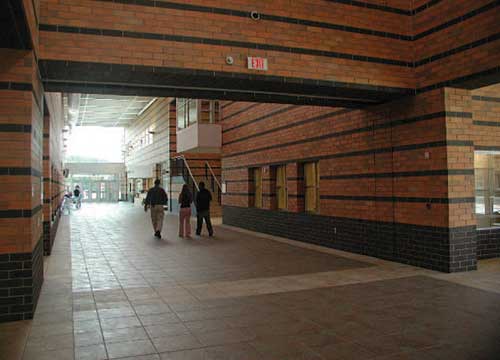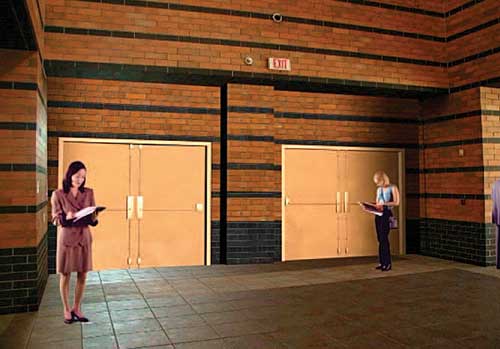Horizontal Sliding Fire Doors: Catalyst for Architectural Versatility
How Do They Function?
Horizontal fire-rated accordion-type sliding doors are customdesigned to be stored in shallow recessed pockets in walls. Monitored and controlled by electronic systems, they self-close in the event of fire. In addition to there being no restrictions on the width of the size of openings in UL listings, sliding door systems can reach the new 2008 UL-approved maximum height of 28-feet (taller applications, however, can be considered on a case by case basis). Moreover, because no floor track is required, they may be specified for radial configurations. With track detail recessed above the ceiling and accordion doors that fold to just inches per foot behind a pocket door, they are virtually invisible until activated. Sliding fire door systems are not applicable in openings designed for doors that are normally closed.

A typical horizontal sliding door system employs a two-track system. Door panels are manufactured from 24-gauge steel and weigh 5.5 pounds per sq ft. Panels are 4-1/2 inches wide, corrugated for strength. Between the two tracks is a 6-inch to 8-inch dead air space.
The door assembly suspension and driver systems are independent. Each folding door panel is suspended from an overhead track with a steel pin and roller assembly to increase durability and to make maintenance easier. The door can be completely repaired in place because individual panels may be removed and replaced. Door assemblies have separate UL listings according to their fire rating, which is determined by building and fire codes. These are 20 minutes, one hour, one-and-a-half hours and three hours (20, 60, 90 and 180 minutes.)
The sliding door system is designed to remain in the open position. Upon a signal from the building fire alarm panel, smoke alarm, fire alarm, a manual pull station or, in some instances, the activation of a sprinkler flow valve, the door will automatically close. Opening and closing speeds are regulated by National Fire Protection Association (NFPA) Code, which requires speed of not less than six inches per second and not to exceed 24 inches per second. The typical rate of opening and closing is between eight and nine inches per second. At this rate of speed a clear opening width of 80 or 90 inches can be created in ten seconds.
The door assembly's sophisticated electronic control system operates on a 120-volt AC system that includes a backup battery system and microprocessors that continuously monitor the door systems. The 120-volt line is connected to a junction box in the storage pocket near the control box and continuously charges the battery. Upon activation, a high decibel sound indicates that the system is in fire mode and the door closes. If the leading edge of the door, equipped with a special sensor, encounters an obstruction, it will stop, pause momentarily and then continue closing. Only light pressure on the leading edge is required to cause the door to stop.
When in the closed position, it can be reopened easily from either side. Only three to five pounds of pressure on the fire exit hardware will cause the door to retract a certain preset distance, typically 36 inches, pause and recycle to the closed position. The retractable distance was originally designed in conjunction with California Department of Rehabilitation engineers who were studying methods for evacuating persons with disabilities from multi-story buildings during fire emergencies. Most manufacturers set the force to open at five pounds or less to comply with Americans with Disabilities Act (ADA) requirements for fire doors in egress applications. The distance the door retracts can be adjusted in the field.
Resetting the door assembly can be accomplished by pushing the Open/Close rocker switch on the leading edge of the door to the close position. When not in fire mode, this control can also be used to position the door as desired.
 |
 |
Without a fire-rated sliding door system protecting the exit in this school, the corridor would require a wall and swinging doors, which could cause (Top) Photo courtesy Mark Thomas Productions Ltd. , (Bottom) Illustration by Gary Rackcliff |
Â
The typical sliding door system is designed, UL-listed and installed so that it does not close upon power loss in the building, unless the loss of power is for a sufficiently long period of time that the voltage in the battery falls to around 11 volts. In typical openings the door is capable of completing well over fifty complete opening and closing cycles on battery power alone. The door is also designed to be operated manually.
Because the door's drive system is structurally independent of the door's suspension system, any force applied to the door's surfaces will not obstruct the functioning of the door. Nor will any likely substantial deflection of the door have more than a minimal effect on the door's opening or closing. Logic circuitry in the control unit prevents the door from opening when heat sensors detect a high temperature or fire condition on either side of the door.









